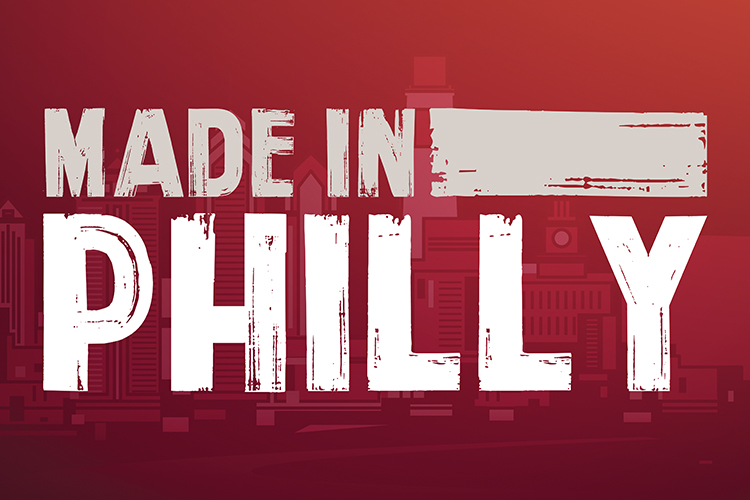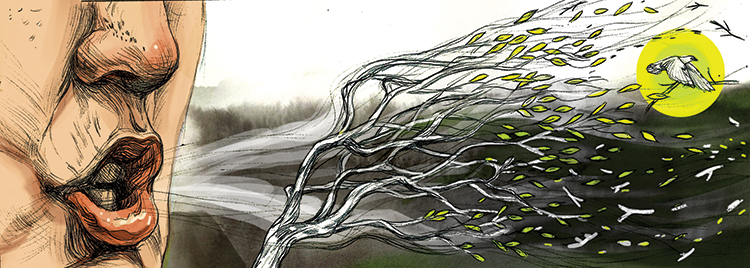Illustration by Lauren Rebbeck
Victory Lap
by Debra McCarty
Despite its absolute necessity, clean water is something many take for granted. This was clear in the collective response to stories emerging from Rio de Janeiro during the 2016 Summer Olympics about waters tainted by the unchecked flow of sewage and other pollution. Confronted by the reality that some 6 million Rio citizens face unsafe water as a part of daily life, our response seemed to be one of distancing: That could never happen here in the United States, we said.
But it wasn’t all that long ago that sewage and other pollution impacted our very own waters in ways not too different from what we see in Rio today. Consider that, in 1973, one Environmental Protection Agency study concluded that the Delaware River would never again achieve fishable uses.
Once a waterway has been polluted and degraded, it’s not a problem we fix overnight. In 1982, when I first started at the Philadelphia Water Department (PWD), it was in many ways a darker time for our own waterways. In those days, you might see a few fishermen on the upper reaches of the urban Delaware, but they didn’t venture far into the city. The Clean Water Act, passed a decade earlier, was just beginning to have an impact.
I am proud to have served the city for the last 34 years and to lead PWD as we continue the noble work of improving those waters. Today, our rivers are clean enough to attract a wide variety of recreation and sports—including once unimaginable, water-quality-dependent national events, such as professional fishing tournaments and even competitive triathlons like the ones at the Rio Olympics.
That transformation is inspiring, but our work is incomplete. As the ultimate guardians of our water, we are never satisfied, and we are investing billions in a multi-administration, multi-generational effort to make our rivers and creeks cleaner.
In 2016, Philadelphia and nearly 900 other communities are engaged in the next phase of the Clean Water Act’s challenge: the fight against excessive stormwater runoff and resulting in combined sewer overflows. Basically, these are times when heavy rains overwhelm the sewers, sending a mix of stormwater and diluted sewage into our streams and rivers.
Since “Green City, Clean Waters” was formally adopted in 2011, PWD, with the spirited assisstance of our partners, has reduced overflows by 1.5 billion gallons per year, making our waterways that much more valuable as recreational assets. Now, we face the challenge of truly bringing this program to a scale that will protect waterways like never before.
The ultimate goal is to reduce combined sewer overflows on the Pennypack, Cobbs and Tacony creeks, as well as into the Schuylkill and Delaware rivers, by 85 percent—8.9 billion gallons annually—by 2036.
It may seem daunting, but reducing that pollution is what it will take to make our waterways much closer to being as beautiful, accessible, fishable and swimmable as Philadelphia deserves for them to be.
The good news? We’re making headway right now, and the improvements aren’t just numbers in a government report. They come with real changes for Philadelphians in every neighborhood: improved property values, neighborhood pride and stewardship, a growing green-jobs economy and a citizenry highly engaged around water issues.
With hundreds of greened and water-absorbing acres already in place, residents citywide are now experiencing what will soon be the norm for many more communities: green infrastructure as a central piece of the neighborhood social fabric.
Today, there are 111 Philadelphia streets that are greener for the residents and better for our waterways, thanks to green tools like stormwater-absorbing tree trenches and planters.
There are 18 parks where green infrastructure investments enhance facilities while protecting neighborhood watersheds.
At our schools, 11 campuses have been reinvigorated with rain gardens and trees that minimize stormwater impacts and create spaces where our children learn about the urban water cycle.
In this way, “Green City, Clean Waters” works to improve Philadelphia on two fronts—with each new green infrastructure site, we take another step toward improving our waterways to make them more beautiful, accessible, fishable and swimmable, all while making Philadelphia a greener, better place to live at its core.
When I look at our rivers today, I see a city that has triumphed over the pessimism of the past. My 1982 self would hardly have believed that a place like Spruce Street Harbor Park would be the go-to summer spot in 2016, complete with paddle board yoga and pedal boats. That sea change only hints at what can be achieved if we continue our trajectory toward cleaner water with even greater enthusiasm.
Clean water is a necessity for a healthy city, but bringing our rivers and creeks into a new era of water quality will be an invaluable investment in Philadelphia, making the city even more attractive to businesses and development, potential residents, showpiece recreational and sporting events, and, most importantly, the people who call it home.
Debra McCarty is an engineer who first joined the staff of the Philadelphia Water Department in 1982. In 2016, she was appointed as its commissioner by Mayor Jim Kenney.










